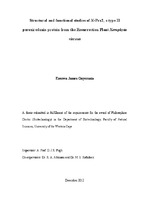| dc.contributor.advisor | Pugh, David J.R. | |
| dc.contributor.advisor | Atkinson, A | |
| dc.contributor.advisor | Rafudeen, M. S. | |
| dc.contributor.author | Onyemata, Ezenwa James | |
| dc.date.accessioned | 2016-08-23T10:52:01Z | |
| dc.date.available | 2016-08-23T10:52:01Z | |
| dc.date.issued | 2012 | |
| dc.identifier.uri | http://hdl.handle.net/11394/5206 | |
| dc.description | Philosophiae Doctor - PhD | en_US |
| dc.description.abstract | XvPrx2 is a 1-Cys-containing member of the Prx5 subfamily of peroxiredoxins isolated
from the resurrection plant Xerophyta viscosa. It is reported to be up-regulated during
periods of desiccation and to protect nucleic acids and cellular proteins from oxidative
damage through scavenging of reactive oxygen species, suggesting that it may play a
role the desiccation tolerance of X. viscosa (Govender, 2006). Members of the Prx5
subfamily have previously been reported to occur as non-covalent homodimers
associating across an A-type interface. PrxD from Populus tremula, a close homologue
of XvPrx2, forms disulphide bonds with glutathione (glutathionylation) resulting in the
unfolding of the Cp-loop and α2-helix and disruption of the homodimer, on the basis of
which glutathionylation has been proposed as a physiological mechanism for
regeneration of all members of the Prx5 subfamily (Noguera-Mazon, et al., 2006b). | en_US |
| dc.language.iso | en | en_US |
| dc.publisher | University of the Western Cape | en_US |
| dc.subject | Peroxiredoxin protein | en_US |
| dc.subject | Resurrection plant | en_US |
| dc.subject | Xerophyta viscosa | en_US |
| dc.title | Structural and functional studies of XvPrx2, a type II peroxiredoxin protein from the resurrection plant xerophyta viscosa | en_US |
| dc.type | Thesis | en_US |
| dc.rights.holder | University of the Western Cape | en_US |

